
HOSTS- Jeremy Burns, Matthew Scott Phillips
TYPE- Ear Training
DURATION- 111:47
BUMPER MUSIC- "Birminghamlandia"
(Area 47 Music)
ANNOUNCER- Mike Cunliffe
Continuing where episode 73 left off, this episode will review our previous discussions on diatonic chords and secondary functions. We will now add the secondary seven of III and seven of VI chords. Listen for the chord qualities and use your theory brain to find out how to decipher these chord progressions. Use this skill to learn songs faster and know music better!
The following examples reflect the opening examples on episode 98. Though the arrangement of notes may not be 100% accurate, the progressions will be the same.
-See the chord in measure 2. This chord is a diminished chord built on scale degree #2 (A#), in the bass and soprano voices.
-In the key of G major, the A#º is a CHROMATIC chord. It is the SECONDARY SEVEN of the iii chord
(B minor). The once natural A, is now an A#. It is acting as the LEADING TONE, moving up to the B (scale degree 3) in the chord that follows.
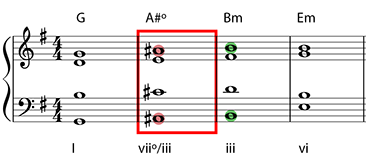
-The viiº/vi, in major, appears in measure 3. This chord is a diminished chord built on scale degree #5 (E#) that resolves to scale degree 6 (F#). We use E# instead of F because this is still considered to be scale degree 5 (E), only raised a 1/2 step.
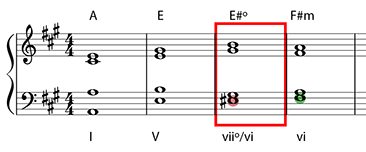
-The chord in measure 2 is a diminished chord built on scale degree 2 (B), in the bass and tenor voices.
-In the key of A minor, the Bº is a DIATONIC chord. It already belongs to the key of Am. In this case, instead of functioning as the ii, it is the SECONDARY SEVEN of the III chord (C major). The B is acting as the LEADING TONE, moving up to the C (scale degree 3) in the chord that follows.
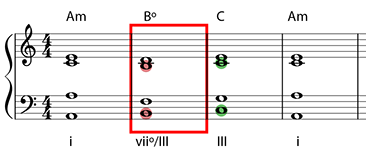

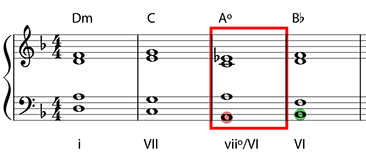
Let's take four listens to identify this chord progression. Below is a good strategy on how to use your listens wisely for each time the progression is played.
1st LISTEN-THE BASS
Use this listen to focus on the bass line. In our first example, we hear the following scale degrees in the bass, beginning with scale degree 1 (G):
1 - 4 - #5 - 6 - 6 - 5 - 1
Notate it!

2nd LISTEN-THE SOPRANO
Use this listen to focus on the melody, or the soprano voice. When you hear that note, try to identify what scale degree it is and where it goes from there. Sometimes singing (in your head), from the identified note down to the the tonic, can help zero in on what scale degree it is. In this case, we hear that scale degree 3 begins the following progression in the highest voice:
3 - 3 - 2 - 3 - 4 - 4 -3
Notate it!

3rd LISTEN-THE THEORY BRAIN
Something harmonic is coming together! We now have enough information to ENGAGE OUR THEORY BRAIN and start making educated guesses at how this progression might develop. Now, we will listen for chord qualities. Here's an example of the process:
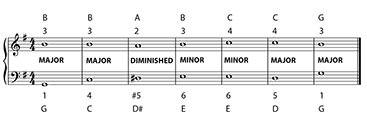
-1st CHORD- Has two notes from the tonic chord (G and B) and sounds like a major chord. The tonic is in the bass as well. Let's call it I.
-2nd CHORD- Has the C note (scale degree 4) in the bass and the B note (scale degree 3) in the soprano. That doesn't tell our eyes that much. But listen! It sounds like a MAJOR chord. Let's call this a IV chord. It sounds like there could be another note in there too. Maybe the 7th of the chord?
-3rd CHORD- This chord has a little chromaticism. We have a D# in the bass and an A in the soprano. This chord sounds "crunchy" too. Could this be a secondary viiº chord? Where will that D# go?
-4th CHORD-Has an E note (scale degree 6) in the lower voice and B (scale degree 3) in the upper voice. It sounds like a minor chord and includes two notes from E minor (the vi chord). Also, that D# resolved up to an E, the root of the vi chord.
-5th CHORD-Has an E note (scale degree 6) in the lower voice and C (scale degree 4) in the upper voice. It sounds like a minor chord and includes two notes from A minor (the ii chord).
-6th CHORD- We hear a major chord. Listening a little closer, this really feels like a V7 chord, especially after we here the chord that follows. The D in the bass and the C in the soprano are both members of the V7 chord.
-7th CHORD- Again, we hear a major chord. We have an C note (scale degree 1) in the bass and an E note (scale degree 3) in the soprano. We know that the previous chord, V, tends to move to I. This sounds pretty complete. Let's call this I.
4th LISTEN-CONFIRMATION
Ideally, this listen will be your confirmation listen. Check out all the voices you filled in and make sure they make sense with what you're hearing.
Here's what it will look like:

NOW LISTEN AS WE APPLY THIS APPROACH TO THE NEXT EXAMPLES
-When trying to determine which scale degree is in the highest voice, try singing down the scale from that note. If you feel you've reached the TONIC on the 3rd note down, that note is the 3rd. If you can keep going, perhaps not.
-Try practicing progressions using these chords, using CHORALE or KEYBOARD styles.
-Don't neglect the MINOR keys while working on these progressions.
-Try to get good at singing "in your head" or to your self. When you hear a chord, try to arpeggiate the notes in your head.
-Try to get good at identifying the bass lines when listening to music. These will be the first that you will want to identify when taking your listening exams.
-Budget your listens wisely. First identify the lowest notes. Second, identify the highest notes. Use the third listen to engage your theory brain and then the fourth to confirm.
